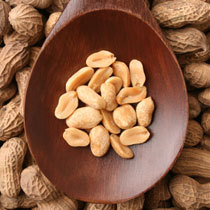As nitrogen-fixers, legumes are a great crop for farmers because of their ability to enrich soil fertility by depositing nitrogen in the soil. In addition to this service to the environment, legumes provide an important source of protein. And when they are cooked and served up with the right spices, they make a delicious meal.

Today Nourishing the Planet takes a look at five nutritious legumes that are also helping the environment:
1. Black Bean: Black beans are a great source of protein and fiber. And they’re low in fat and sodium, too. A one-cup serving size of black beans has nearly 15 grams of both protein and fiber, which is equivalent to about 2 ounces of chicken. Also known as frijoles negros, they are popular staples in many Latin American countries, including Brazil, Cuba, the Dominican Republic, Guatemala, and Mexico. Spanish conquistadors introduced black beans to Europe around the 15th Century, and from there, they spread to Asia and Africa. Black beans are usually inexpensive, can be bought either dried or canned, and are easy to store.
Black Bean in Action: Not only do rice and beans make a healthy and delicious meal, but they also create something called a complete protein. Since rice contains low levels of essential amino acids, and dry beans contain those essential amino acids, when paired together they create all the nine amino acids necessary to form a complete protein, according to the U.S. Centers for Disease Control and Prevention.
2. Lentil: Lentils come in a wide variety of colors: black, yellow, orange, green, red, and brown. They originated in Central Asia and are used in various cuisines, including Indian, Turkish, and Syrian, among others. One serving—or one cup—of lentils contains 18 grams of protein and only 1 gram of fat! They have no cholesterol, are low in salt, and are filled with tons of nutrients, including vitamins A, B6, C, K, E, and Riboflavin.
Lentil in Action: Like all legumes, lentil seeds grow in pods that grow on a plant. The plant is about 16 inches tall. Lentil plants play an important role in increasing the amount of nitrogen and other nutrients in the soil during growth. By adding nitrogen to the soil, they provide for other plants and crops and can also help to prevent soil erosion.
3. Chickpea: Also known as a garbanzo or ceci beans, one cup of chickpeas provides nearly 50 percent of the daily-recommended amount of fiber. In addition, chickpeas contain antioxidants that can lower the risk of cardiovascular disease. They originated in the Middle East and were first cultivated around 3000 B.C.E. Today, they are used in many Indian and Middle Eastern dishes.
Chickpea in Action: It generally takes about 100 days for chickpeas to reach harvest time. When planting chickpea seeds, it is best to grow them near other crops like potatoes, cucumbers, corn, and strawberries. Similar to lentils, chickpea plants work with microorganisms in the soil to provide nitrogen-fixing bacteria and help other surrounding crops grow.
4. Mung Bean: In the United States, mung beans are typically known as bean sprouts. They are grown throughout Southeast Asia, parts of Africa, Australia, South America, and India. The mung bean is closely related to the adzuki bean. In the U.S., the bean sprout is usually eaten, but in China cooks use both the sprout and the whole bean.
Mung Bean in Action: Although mung beans have great nutritional benefits (they are low in both fat and calories and contain dietary fiber and vitamins A and K), they are also used for medicinal reasons. In China, mung beans are used to treat heat rash, heatstroke, food poisoning, mumps, and skin conditions, including boils and burns.
5. Peanut: Unlike other legumes that grow on plants, and other nuts, which grow on trees, peanuts actually grow underground. According to the Peanut Institute, the peanut plant is thought to have originated in South America. It has since spread to Asia, Africa, and North America. The current top 3 producers of peanuts are China, India, and the U.S., according to the U.S. Department of Agriculture’s (USDA) Foreign Agricultural Service. In the U.S., peanuts are also widely consumed, and they account for about 67 percent of all nuts consumed in the country. Just one ounce of raw peanuts contains nearly 7.3 grams of protein. Although they are high in fat and calories, peanuts provide a substantial amount of energy in one small bite.
Peanut in Action: According to the USDA, more acres are devoted to growing peanuts than any other fruits, vegetables or nuts in the United States. Many supermarkets and local, organic food stores now have areas where you can actually grind your own peanuts to make peanut butters, without the added oils and sugars. And in Zambia, Community Markets for Conservation (COMACO) is helping to improve farmers’ livelihoods and regional food security by producing organic peanut butter.
By Christina Wright

Danielle Nierenberg, an expert on livestock and sustainability, currently serves as Project Director of State of World 2011 for the Worldwatch Institute, a Washington, DC-based environmental think tank. Her knowledge of factory farming and its global spread and sustainable agriculture has been cited widely in the New York Times Magazine, the International Herald Tribune, the Washington Post, and
other publications.
Danielle worked for two years as a Peace Corps volunteer in the Dominican Republic. She is currently traveling across Africa looking at innovations that are working to alleviate hunger and poverty and blogging everyday at Worldwatch Institute’s Nourishing the Planet. She has a regular column with the Mail & Guardian, the Kansas City Star, and the Huffington Post and her writing was been featured in newspapers across Africa including the Cape Town Argus, the Zambia Daily Mail, Coast Week (Kenya), and other African publications. She holds an M.S. in agriculture, food, and environment from Tufts University and a B.A. in environmental policy from Monmouth College.








